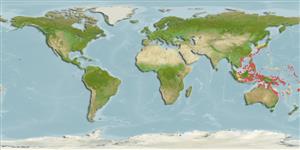Common names from other countries
>
Blenniiformes (Blennies) >
Tripterygiidae (Triplefin blennies) > Tripterygiinae
Etymology: Enneapterygius: Greek, ennea = nine times + Greek, pterygion = little fin (Ref. 45335).
More on author: Fricke.
Environment: milieu / climate zone / depth range / distribution range
Ecologia
marino associati a barriera corallina; distribuzione batimetrica 0 - 18 m (Ref. 27223). Tropical
Western Pacific: Japan, Taiwan, Philippines, Indonesia, Papua New Guinea, Australia, Palau, and Guam.
Size / Peso / Age
Maturity: Lm ? range ? - ? cm
Max length : 4.0 cm TL maschio/sesso non determinato; (Ref. 90102)
Short description
Morfologia | Morfometria
Spine dorsali (totale): 14 - 18; Raggi dorsali molli (totale): 6-11; Spine anali 1; Raggi anali molli: 16 - 20. Male with reddish head and body, row of white blotches along side, additional row of white saddles on back, blackish tail, and black "mask" on front and lower half of head. Female translucent yellowish or orange with faint dark saddles/streaks on back. Dorsal rays III + XI-XV + 6-11; anal rays I,16-20; pectoral rays 16-18; pelvic rays I,2; lateral line interrupted, 13-20 + 13-22; head, chest, and pectoral-fin base scaleless; simple orbital tentacle present; mandibular pores 3-6 + 2-8 + 3-6. Maximum size to 4 cm TL (Ref. 90102).
Adults occur in shallow waters, mainly on the reef flat or crest. They are found on shady vertical rock walls with some current and relatively high oxygen level (Ref. 27223). Eggs are hemispherical and covered with numerous sticky threads that anchor them in the algae on the nesting sites (Ref. 240). Larvae are planktonic which occur primarily in shallow, nearshore waters (Ref. 94114).
Life cycle and mating behavior
Maturità | Riproduzione | Deposizione | Uova | Fecundity | Larve
Fricke, R., 1997. Tripterygiid fishes of the western and central Pacific, with descriptions of 15 new species, including an annotated checklist of world Tripterygiidae (Teleostei). Theses Zool. 29:1-607. (Ref. 27223)
IUCN Red List Status (Ref. 130435)
CITES (Ref. 128078)
Not Evaluated
Threat to humans
Harmless
Human uses
Informazioni ulteriori
Age/SizeAccrescimentoLength-weightLength-lengthLength-frequenciesMorfometriaMorfologiaLarveDinamica popolazioni larvaliReclutamentoAbbondanza
BibliografiaAcquacolturaProfilo di acquacolturaVarietàGeneticaElectrophoresesEreditarietàMalattieElaborazioneMass conversion
CollaboratoriImmaginiStamps, Coins Misc.SuoniCiguateraVelocitàModalità di nuotoArea branchialeOtolithsCervelliVista
Strumenti
Special reports
Download XML
Fonti Internet
Estimates based on models
Preferred temperature (Ref.
115969): 24.7 - 29.3, mean 28.5 (based on 1586 cells).
Phylogenetic diversity index (Ref.
82804): PD
50 = 0.5000 [Uniqueness, from 0.5 = low to 2.0 = high].
Bayesian length-weight: a=0.00562 (0.00258 - 0.01228), b=3.08 (2.89 - 3.27), in cm Total Length, based on LWR estimates for this (Sub)family-body shape (Ref.
93245).
Trophic level (Ref.
69278): 3.1 ±0.3 se; based on size and trophs of closest relatives
Resilienza (Ref.
120179): Alto, tempo minimo di raddoppiamento della popolazione meno di 15 mesi (Preliminary K or Fecundity.).
Fishing Vulnerability (Ref.
59153): Low vulnerability (10 of 100).
